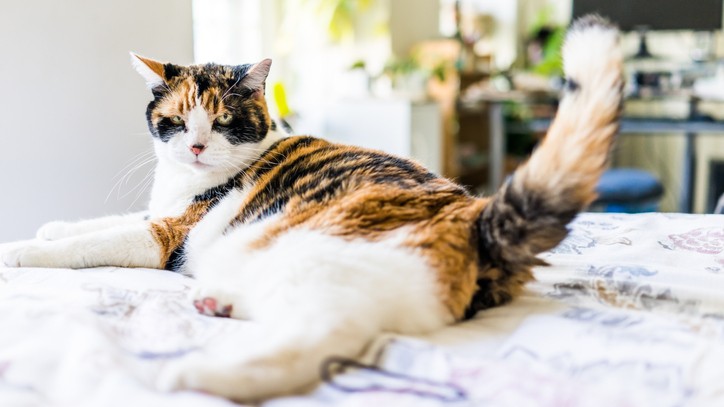Why do cats wag their tails?
Why do cats wag their tails and what are the tales behind those moves?

Have you ever wondered, “Why do cats wag their tails?”. We've seen them do it each and every day – flicking their tails from side-to-side or thumping them to the floor, seemingly in a random manner. There are, however, hidden meanings behind each movement. And, if you can learn the ways of the wag, then you'll better understand your feline friend.
Here’s what you should do: consider tail swishing as a cat code that you're just about to crack. Understand, too, that kitties are complex little things, with even the friendliest cat breeds veering from one mood to another depending on the situation they find themselves in.
By paying careful attention to a feline's tail, you'll better judge what emotion is being conveyed. What’s more, it could be the difference between a hugely enjoyable play session with your kitty and one that leaves you screaming all the way to the first aid box.
- How to play with a cat: A vet’s guide to keeping your cat entertained
- Why does my cat bite me? 7 reasons this could be happening
Is a cat wagging its tail good or bad?
One thing you'll discover is that there are nuances to be learned. Cats have a unique body language, so if you see a cat's tail wagging, you can't simply exclaim, “cripes, kitty's angry!” or “hey, there's a happy cat!” – you have to pay attention to the exact action that is being performed.
What this means is that, yes, a cat wagging its tail is potentially bad. It can be expressing a kitty's anger or showing they’re upset over something and, in moments like that, you'd do well to either steer clear or approach with caution for fear of falling foul of a quick-action claw.
In some situations, though, a cat wagging its tail is potentially good news. Some tail positions immediately show your cat is in a friendly and confident mood. At this point, they may be popping over to greet you or expressing great excitement that you're around. In these situations, playtime is on!
Cat tail meanings
So what exactly is your cat trying to tell you? Well, the secret is to assess the speed and direction in which the tail is being wagged, making a note of which part of the tail is moving, how high or low it is in relation to the ground, and whether or not it is being puffed up. With that in mind, let's look at the typical behaviors and what they mean.
A swaying tail: Direction and speed are important when assessing a swishing tail. When cats slowly move their tail from side-to-side, it is a sign that they want to be left alone because a situation is making them unhappy. But if they are quickly swishing their tail, it's a sign that a cat is being playful and getting ready to pounce.
Tail-end twitching: If a cat is twitching the end of its tail, then look around to see what could be occupying its attention. Cats perform this tail action when they are playing or hunting but it is also an indicator that the kitty is feeling a little agitated. Again, if this looks to be the case, then leave well alone for the time being.
A whipping tail: You need to know the difference between a tail that is being strongly thrashed from side-to-side and one that is swaying. A thrashing, whipping tail looks more aggressive and this, it would appear, is entirely the point. A cat is a mere step away from becoming very angry and, if you don't want to be bitten or scratched, you should walk away.
A puffed up tail: If your cat's tail has suddenly doubled in size and become very fluffy, then your feline friend is feeling threatened and is looking to make themselves look larger and more intimidating. It's usually a reaction to encountering another cat or a dog and can be accompanied by a few noises. If this is happening, it's likely confrontation time.
A low tail: Tails that are low to the ground are signs of fear or anxiety in cats and it could be a precursor to aggression. At the very least, it's a defensive, submissive position, more so if the tail is being tucked underneath the cat. Be gentle and approach cautiously – if at all.

A straight up tail: So that's all the bad stuff out of the way. Now on to the good, starting with this: a tail pointing straight up towards the ceiling. This means your cat is confident, on a high, and really happy to see you (is it dinnertime?). It's a real sign of love that has its roots in how kittens greet their mother. It can be accompanied by a little quiver and it's not confined to affectionate cat breeds either. All cats do this.
A question mark tail: Has your cat formed a little question mark at the end of their tail? If so, then they're not about to get all inquisitive. It's a cat's way of asking you to come on over and have some fun. They're very much in the mood for games and being petted. This is also a good opportunity to get out the best cat brush for a spot of grooming.
Twitching tail while sleeping: But what's this? Your cat is moving its tail when you approach or try to talk yet otherwise appears to be asleep. It's the equivalent of a grunt from a sleeping person who's just been stirred and a cat's way of saying, “yes, ok, I know you're there but please let me get some kip, it's only been 10 hours!”.
By keeping an eye out for these tail behaviors, you'll have a better understanding of your cat. For example, if your cat is becoming agitated at your attempts to groom, then ask yourself, “how often should I brush my cat?” to make sure you're not overdoing it.
Likewise, if you're worried that a cat is likely to be bothered by neighborhood moggy, consider the best indoor cat breeds. Indeed, if any form of aggression worries you, maybe even think about the best cats for kids and families or the best cat breeds for first-time owners – these felines will still show signs of frustration but they may be less grumpy. That’s not guaranteed, though!
Why do cats wag their tails while lying down?
Before we wrap up, there is actually another tail action that you need to watch out for – the one that is performed when a cat is lying down. If your feline friend is swishing their tail in this instance, it isn't always an emotional indicator but something you may need to take as a warning.
Cats will wag their tails while lying down if they are feeling unwell or they're in pain. It's an involuntary reflex because, in general, cats don't like to display vulnerability in case it opens themselves up to harm.
In some cases, though, a cat is simply relaxing and swishing out of happiness, frustration or playfulness. So, to be sure, you should look for changes in a cat's behavior. If they're not eating well or hiding away, for instance, or if they're biting or scratching more than usual then it's always worth a trip to the vet.
For more cat content like this, check out our feature on why do cats rub their face on things.
PetsRadar Newsletter
Get the best advice, tips and top tech for your beloved Pets

David Crookes has been a journalist for almost 30 years and he has written for a host of magazines, newspapers, websites and books including the World of Animals Annual, BBC Earth, Live Science, The Independent and Tom’s Guide.
Born in England, he lives with two cats but he’s also keenly interested in the differences between the huge number of dog breeds – in fact, you can read many of his breed guides that he’s written in collaboration with vets here on PetsRadar.
With a lifelong passion for technology, too, he’s always on the lookout for useful devices that will allow people to keep their pets happier and healthier, and provide them more time to spend together.
David has a degree from Durham University, as well as postgraduate diploma in journalism from the University of Central Lancashire.
